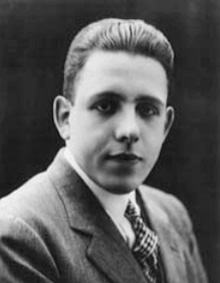Writing to a friend in 1942, Poulenc admitted “I am well aware that I am not the kind of musician who makes harmonic inventions, like Igor [Stravinsky], Ravel or Debussy, but I think there is a place for new music which is content with using other people’s chords. Was that not the case with Mozart and with Schubert?”
The eminent critic Claude Rostande famously described Francis Poulenc (1899 – 1963) as ‘moitié moine, moitié voyou’ (‘half-monk, half-rascal’). Even Poulenc admitted that there were two sides to his character, the “gentle, devout Poulenc” and the “rakish bon-viveur”. His music seems to be the embodiment of a certain urbane Gallic charm – often sophisticated, witty, ironic and sentimental – but elsewhere tinged with melancholy.

A man of independent means, he was affable, easy-going and he effortlessly floated around the aristocratic salon circles of post-war Paris, writing music which borrows unashamedly from other styles but bears his own unmistakeable stamp. In spite of his lack of formal conservatory training, he quickly established himself as a prominent member of a group of young French composers, dubbed Les Six by the critic Henri Collet. An early appreciation of his work was given by his teacher Paul Vidal who told him after hearing his Rhapsodie nègre (1918) dedicated to Eric Satie,“Your work is foul and inept. It’s squalid rubbish!”
His first great success however was with the intoxicating ballet Les Biches (1923) for Serge Diaghilev’s Ballets Russes in which he shows his gift for witty orchestration (including jazz and classical influences) and beguiling, memorable melodies that would become his trademark. His Chansons Gaillardes (1925) are classics of the genre; by setting bawdy 17th century poems to music with folksy melodies and a busy piano accompaniment, his intention seems to be to “épater la bourgeoisie” (‘shock the bourgeoisie’) – but only with a knowing, mischievous wink.
Had he continued in the same vein throughout his career, Poulenc’s music could easily be written off as mere froth on the surface of 20th century music, a composer par excellence of witty divertissements. But following a number of personal tragedies, a seriousness enters his later works even if an irrepressible sense of humour lurks beneath the surface. His popular Concerto for organ, strings and timpani (1938) marks this change.

The work was commissioned by the wealthy Princess Edmond de Polignac (formerly Winnaretta Singer), a noted patron of the arts and an amateur musician herself, having studied under Nadia Boulanger. In 1933, Boulanger became her advisor on new commissions and concerts to be held in her salon. In this capacity she approached Jean Français with a commission for a new organ concerto which he declined, but he nevertheless suggested Poulenc who jumped at the opportunity, even though he had never written for the organ. Boulanger was delighted, writing to him they should discuss “the possibility of writing a work that the princess could eventually play, perhaps with a quartet or a piano”.
Poulenc started work on the concerto in September 1934 but unlike his other compositions which he dished-up with great facility, work on the concerto was painfully slow. In April 1936, he wrote to a friend “The Concerto is nearing the end. It has given me a lot of trouble, but I trust that it is fine as it is … This is not the amusing Poulenc of the Concerto for two pianos but rather Poulenc on his way to the cloister, very fifteenth-century, if you will.”
But tragedy struck in August 1936 when his friend, the young composer Pierre-Octave Ferroud, died in a grisly road accident in Debrecen, Hungary. Poulenc was deeply upset by the news and shortly afterwards made a pilgrimage to the ancient shrine of Notre Dame de Rocamadour. He described the experience later “As I meditated on the fragility of our human frame, I was drawn once more to the life of the spirit. Rocamadour had the effect of restoring me to the faith of my childhood”. This religiosity would find its way into his works in the form of a greater emotional depth, but it rarely suppressed his impish wit.

In November 1936, we find Poulenc asking Boulanger to tell the princess “…that I’m ashamed, but I won’t deliver [the concerto] to her until it is perfect”. When he did finally finish the work in July 1938, (and then only after some arm twisting), he wrote to the princess confessing “never, since I began to write music have I had so much trouble in finding my means of expression”. The concerto was privately performed at the princess’s atelier in December 1938 under the baton of Nadia Boulanger with Maurice Duruflé as soloist and it received its first public performance the following year.
Poulenc was not initially happy with the work, finding it “a little disconcerting and boring”, but his patron and the public disagreed; together with the Concerto for two pianos, it has since become one of his most popular works. It was said of Saint-Saëns’ second piano concerto that it goes from “Bach to Offenbach”; the same could be said of Poulenc’s atmospheric Concerto for organ. From its austere, almost Baroque opening, the concerto lurches from periods of quiet reflection and nostalgia, to exuberant playfulness, interspersed with dramatic outbursts from the organ. If there is one work which perfectly shows the ‘half-monk, half-rascal’ character of Poulenc, this is surely it.
Following the Concerto for organ, Poulenc would turn to writing religious music (including a fine setting of the Gloria) but he remained ever the court jester. Later in life, the devout Poulenc would joke that he “liked living between nuns and sluts”.
Kevin Painting
@berggasse
Published 14 January 2016 on primephonic